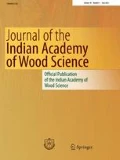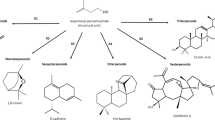Abstract
This study had been done to determine the optimal condition for the extraction of extractives with respect to the temperature and methanol solvent percentage on the total extractives yield from the sapwood, heartwood and bark of Acacia auriculiformis trees. All the disc components; the sapwood, heartwood and bark were air dried under shelter for 2 weeks before it was pulverized into powdered form. The pulverized samples were extracted with methanol solvent in a ratio of 1:20 (pulverized samples: solvent) for 3 h in a water bath. Different temperature (35 °C, 55 °C and 75 °C) and methanol solvent percentage (55 %, 65 % and 75 %) were used for the extraction. The total extractives yield was determined based on Zhang et al. (2007). The total extractives yield was found to be at its optimum at temperature, 75 °C and methanol solvent percentage, 75 % for all the disc components, sapwood (3.00 %), heartwood (9.81 %) and bark (18.89 %).



Similar content being viewed by others
References
Barry KM, Mihara R, Davies NW, Mitsunaga T, Mohammed CL (2005) Polyphenols in Acacia mangium and Acacia auriculiformis heartwood with reference to heart rot susceptibility. J Wood Sci 51:615–621. doi:10.1007/s10086-005-0707-x
Butler LG (1992) Antinutritional effects of condensed and hydrolysable tannins. Basic Life Sci 59:693–698
Cai W, Gu X, Tang J (2010) Extraction, purification and characterisation of the flavonoids from Opuntia milpa alta skin. Czech J of Food Sci 28:108–116
Cao G, Sofic E, Prior RL (1997) Antioxidant and prooxidant behaviour of flavonoids: structure-activity relationships. Free Radic Biol Med 22:749–760
Dash M, Patra JK, Panda PP (2008) Phytochemical and antimicrobial screening of extracts of Aquilaria agallocha Roxb. Afr J Biotechnol 7:3531–3534
Garcia-Lafuente A, Guillamon E, Villares A, Rostagno MA, Martinez JA (2009) Flavonoids as anti-inflammatory agents: implications in cancer and cardiovascular disease. Inflamm Res 58:537–552
Gattuso G, Barreca D, Gargiulli C, Leuzzi U, Caristi C (2007) Flavonoid composition of citrus juices. Molecules 12:1641–1673
Gilman EF, Watson DG (1993) Acacia auriculiformis, Earleaf Acacia. Fact Sheet ST-4. University of Florida. http://hort.ufl.edu/database/documents/pdf/tree_fact_sheets/acaaura.pdf. Accessed 11 June 2010
Harborne JB (1999) Classes and functions of secondary products from plants. In: Walton NJ, Brown DE (eds) Chemicals from plants: Perspective on plant secondary products. Imperial College Press, London, pp 91–186
Harju AM, Kainulainen P, Venalainen M, Tiitta M, Viitanen H (2002) Differences in resin acid concentration between brown-rot resistant and susceptible Scots pine heartwood. Holzforschung 56:479–486
Hillis WE (1987) Heartwood and tree exudates. Springer-Verlag, Berlin
Houghton PJ, Raman A (1998) Laboratory handbook for the fractionation of natural extracts. Chapman & Hall, London
Luque de Castro MD, Tena MT (1996) Strategies for supercritical fluid extraction of polar and ionic compounds. Trends in Analyt Chem 15:32–37
Malviya S, Rawat S, Verma M, Kharia A (2011) Preliminary phytochemical investigations of Acacia nilotica Linn plant. Current Pharma Research 1:91–100
Nisar M, Khan S, Dar A, Rehman W, Khan R, Jan I (2010) Antidepressent screening and flavonoids isolation from Eremostachys laciniata (L) Bunge. Afr J Biotechnol 10:1696–1699
Passialis C, Voulgaridis E, Adamopoulos S, Matsouka M (2008) Extractives, acidity, buffering capacity ash and inorganic elements of black locust wood and bark of different clones and origin. Eur J Wood Wood Prod 66:395–400
Patten AM, Vassao DG, Wolcott MP, Davin LB, Lewis NG (2010) Trees: A remarkable biochemical bounty. In: Sir Barton D, Nakanishi K, Meth-Cohn O (eds) Comprehensive natural products chemistry, vol 3. Elsevier Science & Technology, New york, pp 1173–1295
PIER (Pacific Islands Ecosystems at Risk) (2002) Invasive plant species: Acacia auriculiformis. Institute of Pacific Islands Forestry. http://www.hear.org/pier. Accessed 25 July 2002
Pietarinen SP, Willfor SM, Sjoholm RE, Holmbom BR (2005) Bioactive phenolic substances in important tree species. Part 3: knots and stemwood of Acacia crassicarpa and A. Mangium. Holzforschung 59:94–101
Sanni S, Onyeyili PA, Sanni FS (2008) Phytochemical analysis, elemental determination and some in vitro antibacterial activity of Ocimum basilicum L. leaf extracts. Res J Phytochem 2:77–83
Sathishkumar T, Baskar R, Shanmugam S, Rajasekaran P, Sadasivam S, Manikandan V (2008) Optimization of flavonoids extraction from the leaves of Tabernaemontana heyneana Wall. using L16 Orthogonal design. Nature and Science 6:10–21
Shakya A, Shakya VK, Arya N, Saxena RC (2012) Preliminary physico-phytochemical study of the bark of Acacia nilotica. Res J Pharm Biol Che Sci 3:84–88
Uma DB, Ho CW, Wan Aida WM (2010) Optimization of extraction parameters of total phenolic compounds from henna (Lawsonia inermis) leaves. Sains Malaysiana 39:119–128
Zhang J, Yang J, Duan J, Liang Z, Zhang L, Huo Y, Zhang Y (2005) Quantitative and qualitative analysis of flavonoids in leaves of Adinandra nitida by high performance liquid chromatography with UV and electrospray ionization tandem mass spectrometry detection. Anal Chim Acta 532:97–104
Zhang SQ, Bi HM, Liu CJ (2007) Extraction of bio-active components from Rhodiola sachalinensis under ultrahigh hydrostatic pressure. Sep Purif Technol 57:277–282
Author information
Authors and Affiliations
Corresponding author
Rights and permissions
About this article
Cite this article
Tham, M.W., Liew, K.C. Optimization of extraction conditions with respect to temperature and methanol solvent for sapwood, heartwood and bark extract of Acacia auriculiformis . J Indian Acad Wood Sci 9, 101–104 (2012). https://doi.org/10.1007/s13196-012-0073-4
Received:
Accepted:
Published:
Issue Date:
DOI: https://doi.org/10.1007/s13196-012-0073-4




